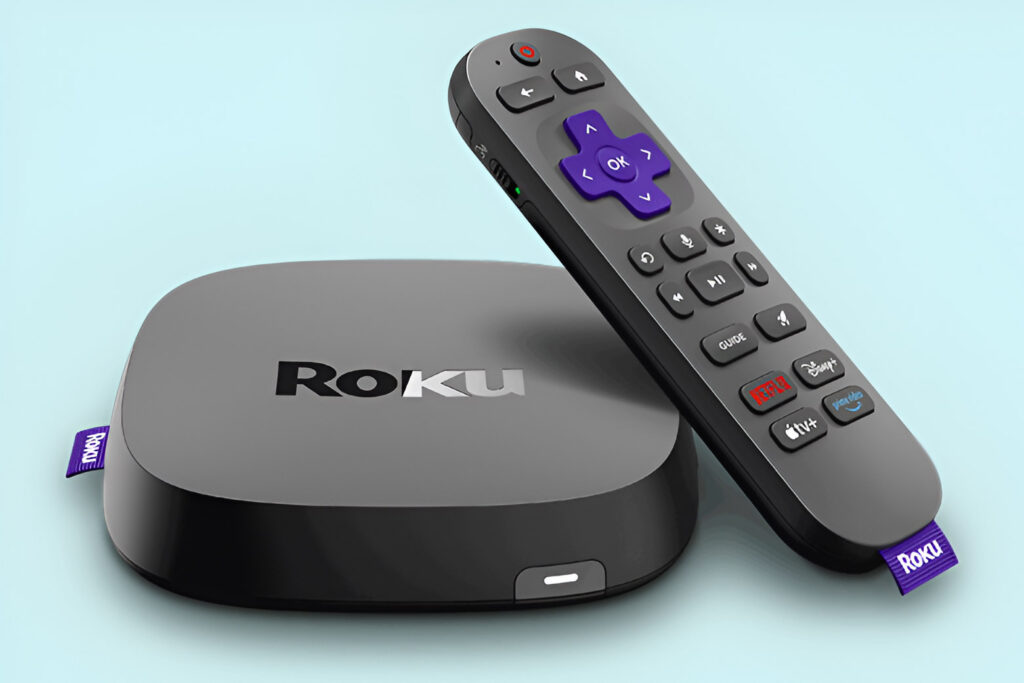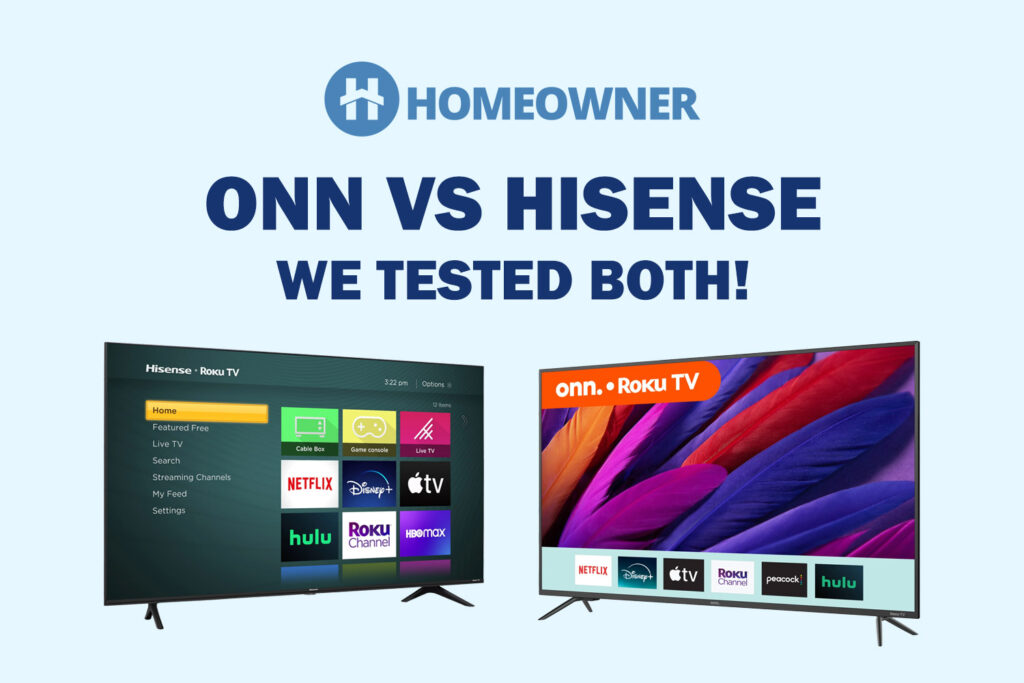In this post:
- 1. Best Overall: TP-Link Archer AXE300
- 2. Best for Gaming: ASUS ROG Rapture GT-AXE11000
- 3. Best Value: TP-Link Archer AXE75
- 4. Best for Streaming: Netgear Nighthawk RAXE300
- 5. Best from Linksys: Linksys MR7500
- 6. Best WiFi 6E Mesh System: TP-Link Deco XE75
- 7. Cheapest Option: Tenda RX27 Pro
- Why Get a WiFi 6E Router?
- Frequently Asked Questions
- Verdict
Being an extended version of WiFi 6, the 6E comes with a new 6 GHz band. It helps manage network traffic better, reduces congestion, and improves signal strength and quality. But with so many WiFi 6E routers in the market, choosing the best one for your needs can be confusing.
Plus, they're more expensive than the ones with WiFi 6. Being a networking hardware enthusiast, I couldn't resist trying them out. So, I got my hands on 17 options, tested them for 3 months, and have picked up the 7 best options for 2025.
Note: These are standalone wireless routers that are suitable for households measuring 1,000 to 2,500 Sq Ft. If you have a large multi-story house, you’re better off investing in WiFi 6E mesh systems.
The devices featured here are checked and vetted for speeds, WiFi coverage, reliability, security, customization, and overall performance. The list is made keeping diverse user needs and budgets. So, you're sure to find a perfect match.
Now, let's get into the reviews.
1. Best Overall: TP-Link Archer AXE300
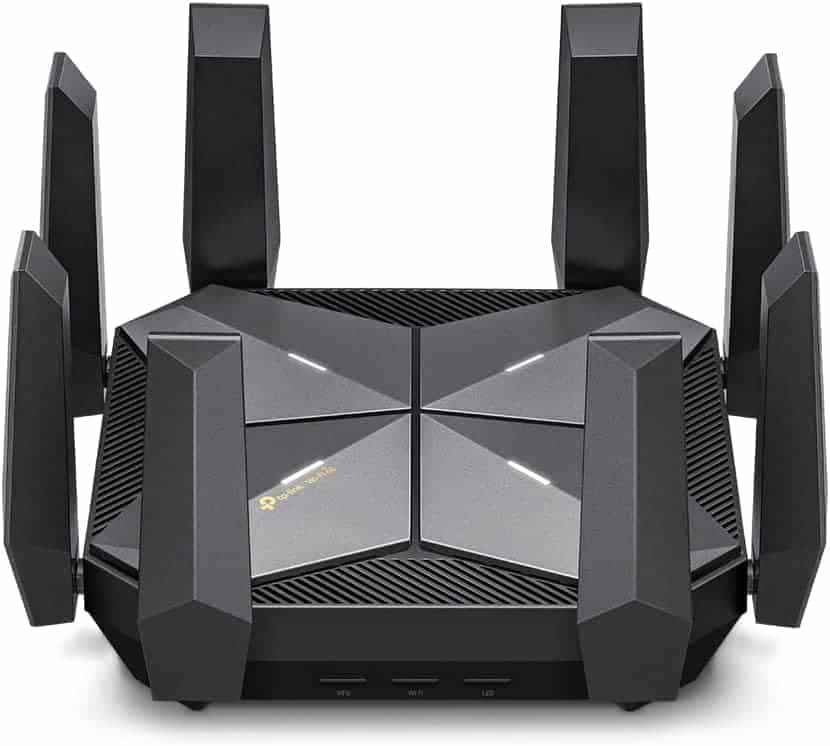
- WiFi Range: Up to 3,000 Sq Ft
- Suitable Internet Plan: 2 Gbps
- Number of Devices Supported: 200+
- Frequency Bands: Quad-Band
- Ports: 1 x 10G RJ45/SFP WAN/LAN + 1 x 10G WAN/LAN + 1 x 2.5G WAN/LAN + 4 x 1 Gig LAN + 1 x USB 3.0
TP-Link AXE300 takes over its preceding model, Archer AX11000. Besides its 2.0GHz quad-core processor, an aggregated speed of 16000 Mbps and a massive selection of ports (including a 10 Gbps port) make it the best Wi-Fi 6E option on the market.
Why is it a suitable choice?
TP-Link Archer AX11000 packs a host of high-end features to qualify as the best overall choice. It operates on a quad-band frequency, making many WiFi channels available, contributing to its excellent performance. The availability of two 10 Gbps Ethernet ports is the best I have ever encountered in any router.
Speeds and WiFi Coverage
As mentioned earlier, these routers are known for their speeds, with the availability of additional 160 MHz channels, and this TP-Link device stands on top of the podium. It boasts a massive speed capacity of 16000 Mbps, with band-wise distribution as:
| 6 GHz: 4804 Mbps | 5 GHz(1): 4804 Mbps | 5 GHz(2): 4804 Mbps | 2.4 GHz: 1148 Mbps |
In my speed tests over respective bands, I paired the 2Gbps Xfinity internet plan, and the overall performance was top-notch. Over the 6 GHz band, downloads transpired at 1.92 Gbps, while uploads averaged at 142 Mbps.

At the same time, respective speeds over the 5 GHz band were 1.74 Gbps and 74 Mbps, while the 2.4 GHz band clocked speeds at 1.07 Gbps and 47 Mbps.
Courtesy of additional 6 GHz and 5 GHz bands, the signals were exceptionally clear, and whether you’re streaming, gaming, or video conferencing in the highest quality possible, ensure a no-lag performance.
These bands work harmoniously with the eight-antenna setup to deliver exceptional coverage. My 2,500 Sq Ft test lab was enveloped with strong signals, except for the underground parking area. So, the overall WiFi range is 2,800 Sq Ft, which is great for a stand-alone router.
And courtesy of MU-MIMO, QoS, and OFDMA, stable signals were transmitted over to around 65 devices at a stretch.
Security Features
This is the department where TP-Link Archer AXE300 loses a few points, as despite being a pricey model, it only ships with a free HomeShield plan. There are features like DDoS protection, VPN, WPA3, guest access, access control, and auto-firmware updates. It shall be enough for most home networks.
For parental controls, there are features like website blocking, scheduled access, WiFi pausing, and an internet dashboard with an overall online time viewing. These should let you protect your kids from the dangers of spending too much time online.
Conclusion
In my tests, Archer AXE300 topped the scores in almost every department, and I had an unparalleled experience using this device. However, I wish it came with HomeShield Pro premium security for free.
Pros
- Lightning-fast speeds
- Dual 10 Gbps Ethernet port
- Great wireless coverage
- Easy to set up & manage
- Excellent parental controls
Cons
- HomeShield’s advanced features cost extra
2. Best for Gaming: ASUS ROG Rapture GT-AXE11000
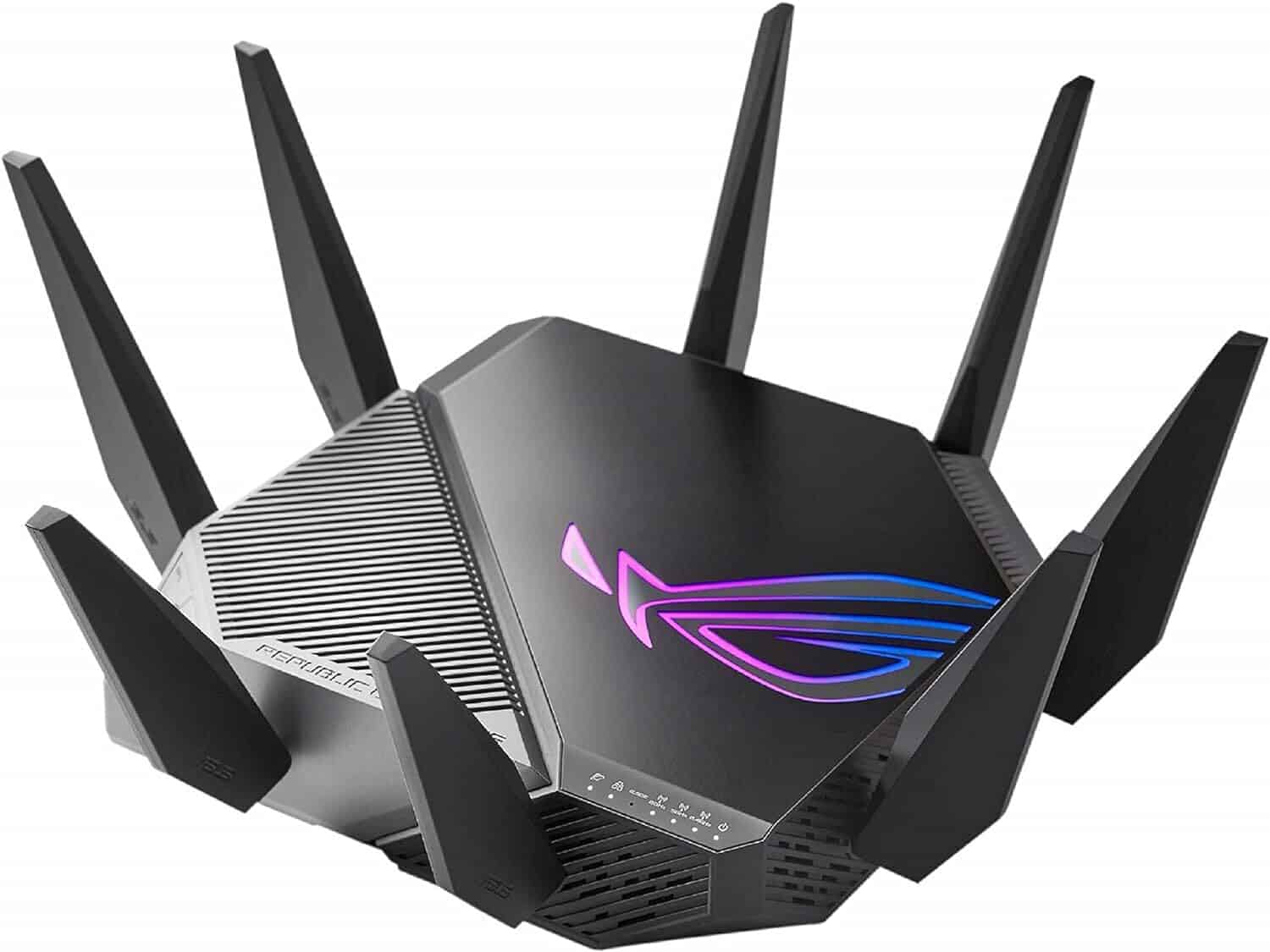
- WiFi Range: Up to 3,500 Sq Ft
- Suitable Internet Plan: 2 Gbps
- Number of Devices Supported: 100+
- Frequency Bands: Tri-band
- Ports: 1 x 2.5G WAN/LAN + 1 x Gig WAN + 4 x Gig LAN + 2 x USB 3.2
If you are a professional gamer and need a gaming router that comes with Wi-Fi 6E, the ASUS ROG GT-AXE11000 is the one I recommend. It's packed with powerful hardware to handle heavy games on multiple devices.
Aside from a tri-band setup, the company has inculcated several gaming-oriented features to enhance its performance a few folds over the GT-6000.
Why is it a suitable choice?
GT-AXE11000 is a holy grail for gamers, as it entails a triple-level game acceleration that establishes a few channels as a game server for faster data transfer. There’s a dedicated gaming port with a 2.5 Gbps speed capacity to fulfill all your devices' bandwidth needs.
Besides, its VPN fusion allows you to connect to a VPN and enjoy maximum gaming speeds.
Speeds and WiFi Coverage
ASUS boasts an aggregated speed of 11000 Mbps, distributed over its three bands as follows:
| 6 GHz: 4804 Mbps | 5 GHz: 4804 Mbps | 2.4 GHz: 1174 Mbps |
I paired up an Xfinity 2 Gbps plan and measured the download and upload speeds over three bands. And expectedly, the performance was exceptional. Over the 6 GHz band, respective values were recorded at 1.89 Gbps and 122 Mbps.
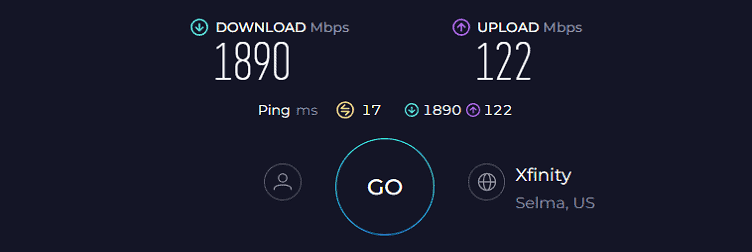
And the best part is signals were never dropped, irrespective of how many devices you connect to. Technologies like MU-MIMO and OFDMA are to be credited for that.
At the same time, the 5 GHz band had values around 1.74 Gbps and 109 Mbps, while it was 1.02 Gbps and 96 Mbps for the 2.4 GHz band.
Although congestion is expected in these compared to the 6 GHz, games like Destiny 2, Valorant, and Red Dead Redemption 2 ran at 15ms ping and 85 FPS.
Moving on, its eight high-performance antennas do wonders in terms of coverage. At a stretch, around 2,900 Sq Ft area was filled with powerful signals, the size of a three-bedroom apartment.
So if you're searching for a good 3,000 Sq Ft router, you can't go wrong with the Rapture GT-AXE11000. Besides, MU-MIMO enhanced its multi-device handling capacity, and I could connect up to 45 gaming consoles and hosted a Fortnite tournament, which concluded well.
Security Features
Security is where this router gets some extra brownie points to its overall score. ASUS AiProtection Pro default, which entails a range of advanced features, and you don’t have to pay a single penny.
The features include anti-malware, intrusion blocking, and malicious website detection, alongside standard ones like WPA3, VPN, guest access, and auto-firmware updates. With these features in hand, the network ecosystem isn’t vulnerable to any unwanted or external threats.
Besides, some advanced parental controls like scheduled access, age-based filters, and tracking online activities.
In this way, digital mothers ensure their children aren’t exposing themselves to unwanted or explicit online activities. So, security-wise, it's on par with some of the most secure routers today.
Conclusion
Asus GT-AXE11000 is an exceptional router for gaming that sets a new standard for speed, coverage, and security performance. In addition to gaming-friendly settings, the device impresses in most aspects.
The reason it’s put in the second position is the availability of less band and throughput capacity compared to my previous suggestion.
Pros
- Exceptional throughput
- Seamless tri-band operation
- Lifetime-free advanced security
- Excellent customization options
- Gaming accelerator
Cons
- Premium
3. Best Value: TP-Link Archer AXE75
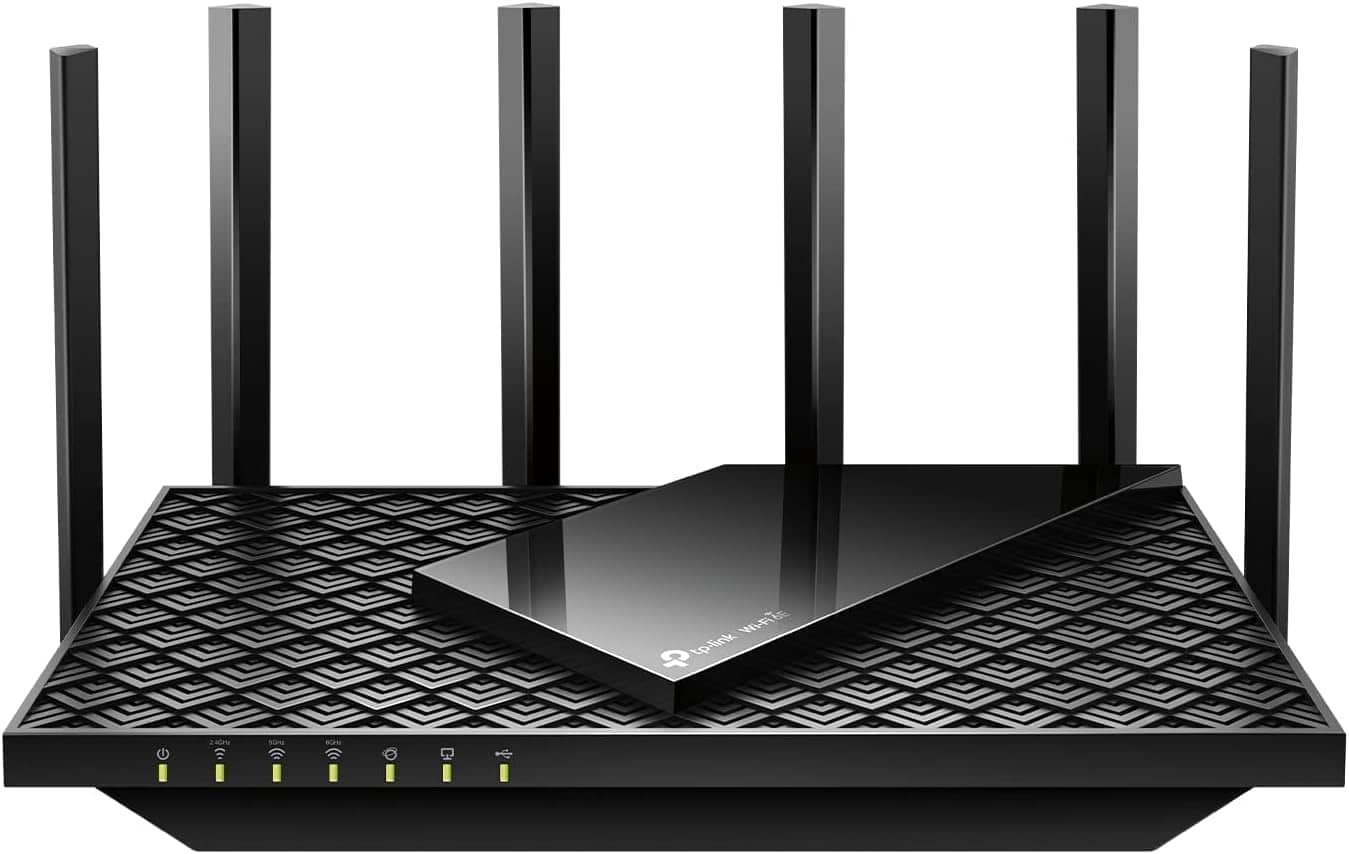
- WiFi Range: Up to 2,500 Sq Ft
- Suitable Internet Plan: 1 Gbps
- Number of Devices Supported: 200
- Frequency Bands: Tri-band
- Ports: 1 x 1 Gig WAN + 4 x 1 Gig LAN + 1 x USB 3.0
Next on my list is the latest WiFi 6E offering of TP-Link in the affordable range, Archer AXE75. Aside from a tri-band offering, its standout feature is its multi-core processor setup, which works harmoniously to deliver a powerful performance.
And when you compare it with its preceding model, you will find plenty of upgrades have been made in the right areas.
Why is it a suitable choice?
Irrespective of the cost, you won’t have to compromise on performance, as the tri-band setup could easily breeze through my hardware-intensive tasks. Although its processor is somewhat entry-level, stay sure about staying lag-free.
It doesn’t instill any multi-gig ports, but its four Gig Ethernet ports let you move beyond the barriers of thick walls and other devices.
Speeds and WiFi Coverage
With TP-Link Archer AXE75, you have plenty of speeds to work with. An aggregate of 5400 Mbps is distributed amongst its bands as:
| 6 GHz: 2402 Mbps | 5 GHz: 2402 Mbps | 2.4 GHz: 574 Mbps |
In my tests, I paired it with a 1 Gbps Xfinity Plan, and despite its lower capacity compared to my previous recommendations, the results were impressive. Over the 6 GHz band, I could complete downloading my long pending 135GB game at 978 Mbps in around 8-9 minutes, while uploads were great at 38 Mbps.
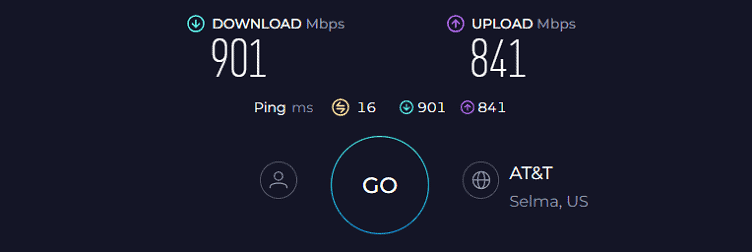
Over the 5 GHz and 2.4 GHz bands, respective downloads were recorded at 927 Mbps and 801 Mbps, while uploads were rated at 39 Mbps and 26 Mbps. With near-gigabit speeds over the 6 GHz band, any heavy or light task shouldn’t budge an inch. Besides, the device performed exceedingly well with multiple devices connected.
Coverage is also the strong suit of this routing device, as its six antenna setup could cover a 2,200 Sq Ft area in my range tests. It’s further OneMesh supported, so you can pair it with a compatible router to double its coverage.
The ingrained technologies like OFDMA and MU-MIMO serve as a helping hand for running high-bandwidth applications on multiple devices without weakening the signals. Depending on your network setup, the number could extend to 65 devices, probably more.
Security Features
With the basic HomeShield security, you’ve got some handy features like access control, guest access, VPN, WPA3, and auto-security updates.
These features, I reckon, should secure your residential network and let you browse anything without compromising your identity.
At the same time, parental control features like scheduled access and WiFi pausing let you ensure that your kids aren’t spending too much time online. At the same time, an internet dashboard feature displays the time your kids spend online. These features combined make it as good as routers designed for parental control.
Conclusion
To conclude, TP-Link Archer AXE75 is an affordable yet reliable device, especially regarding stability and features. Its performance is almost on par with some of the top-rated wireless routers. And when compared to my previous recommendations, it stays way behind them, thereby, its rank.
Pros
- High value for money
- Decent WiFi coverage
- Good security features
- OneMesh expandable
- Handles gigabit speeds
Cons
- No multi-gig Ethernet
4. Best for Streaming: Netgear Nighthawk RAXE300
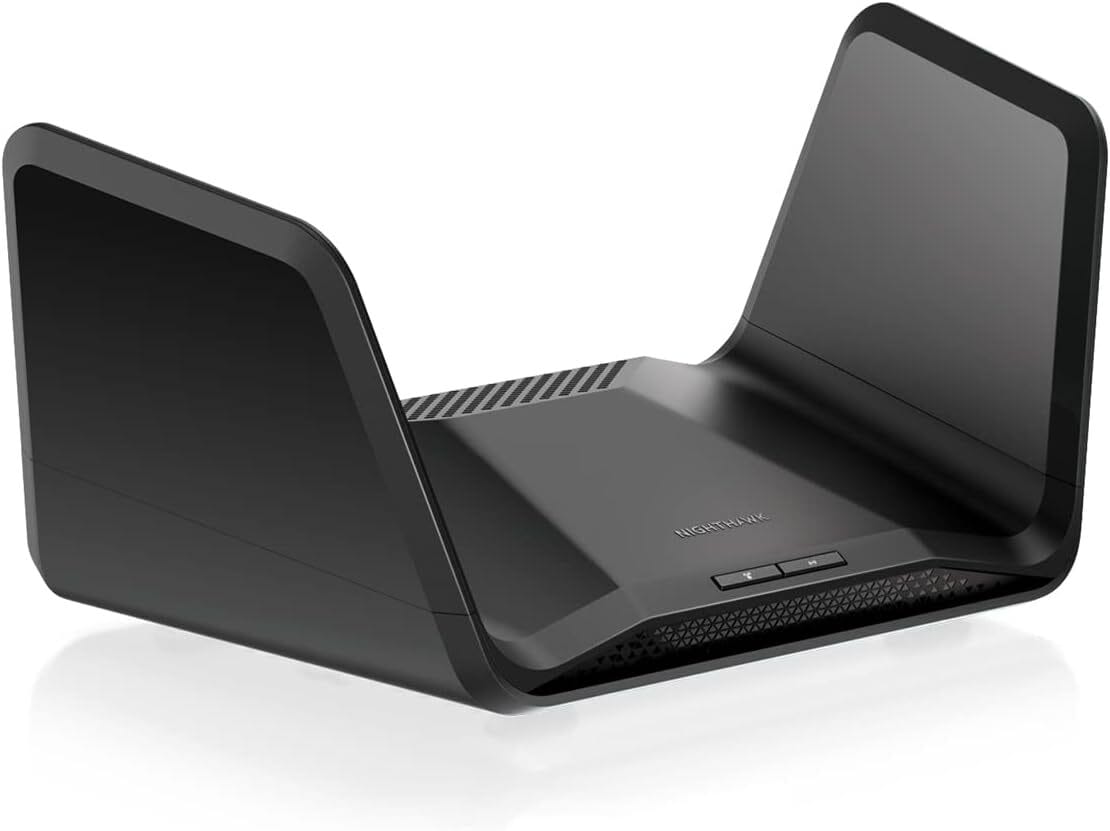
- WiFi Range: Up to 2,500 Sq Ft
- Suitable Internet Plan: 2 Gbps
- Number of Devices Supported: 70+
- Frequency Bands: Tri-band
- Ports: 1 x 2.5G WAN/LAN + 1 x Gig WAN + 4 x Gig LAN
If you’re searching for a reliable and efficient router for streaming, then Netgear RAXE300 should be an ideal pick. It stands out amongst a sea of great options with features like a Quad-Core processor, great throughput capacity, and a multi-gig WAN/LAN port.
If you are a loyal Netgear user, you’ll notice many upgrades to Netgear RAX290 in terms of speed, design, and in turn, overall performance.
Why is it a suitable choice?
For a buffer-free TV streaming experience, the more streams a router has, the better it is. And with twelve streams across its three bands, you can expect a similar performance.
With the further presence of OFDMA, MU-MIMO, and QoS, 8K streams over my 32” HiSense Android TV got a further boost. Besides, connecting my TV directly to the 2.5G port further adds to the experience.
Speeds and WiFi Coverage
Netgear RAXE300, with a tri-band standard coupled with a quad-core processor, boasts an aggregated speed of 7800 Mbps distributed over three bands as:
| 6 GHz: 2.4 Gbps | 5 GHz: 4.8 Gbps | 2.4 GHz: 600 Mbps |
With such stooping speeds, it was only fair to pair with a 2 Gbps Verizon FiOS connection, and the results were impressive.
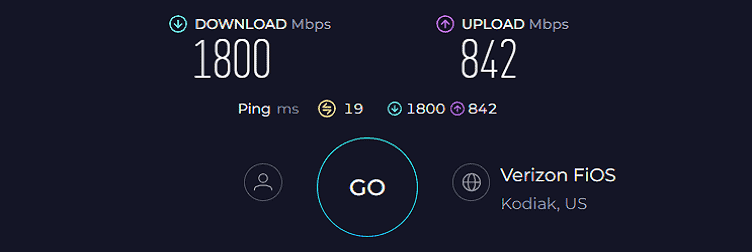
Over the 6 GHz band, downloads and uploads fared at 1.8 Gbps and 842 Mbps, while respective speed values with the 5 GHz band were 1.65 Gbps and 779 Mbps. At the same time, speeds on the 2.4 GHz band were 567 Mbps and 94 Mbps.
Irrespective of such high speeds, its stability is a great thing about it. In my stress tests, the network didn't drop much even after pairing 5 smart TVs, 8 gaming consoles, and many mobile devices. However, 30-foot speed tests on this were pretty disappointing, as connected devices clocked at a 45% drop in speeds.
It can be attributed to considerably weaker antennas, which in my tests, could only cover an area of up to 2,000 Sq Ft. Nevertheless, any mid-sized apartment or a small workspace should work fine with this device.
And courtesy of MU-MIMO, OFDMA, and QoS, I could connect up to 75 devices simultaneously.
Security Features
With Netgear RAXE300, it’s the same story as with the TP-Link, but at an increased price. It brings along a similar set of features for free, like guest access, VPN, WPA3, and auto-firmware updates.
These features make sure the transferred data packets are safe and secure. Besides, it entails handy parental controls like scheduled access and online time tracking.
Conclusion
Netgear RAXE300 is a speedy and stable performer if you can pay for a premium Armor subscription for more advanced security. Its bandwidth and coverage are decent enough to take care of your mid-sized residential and working space.
Pros
- Decent WiFi coverage
- Super fast wireless performance
- 2.5G Ethernet port
- Easy to setup
- Powerful hardware setup
Cons
- Advance paid security
5. Best from Linksys: Linksys MR7500
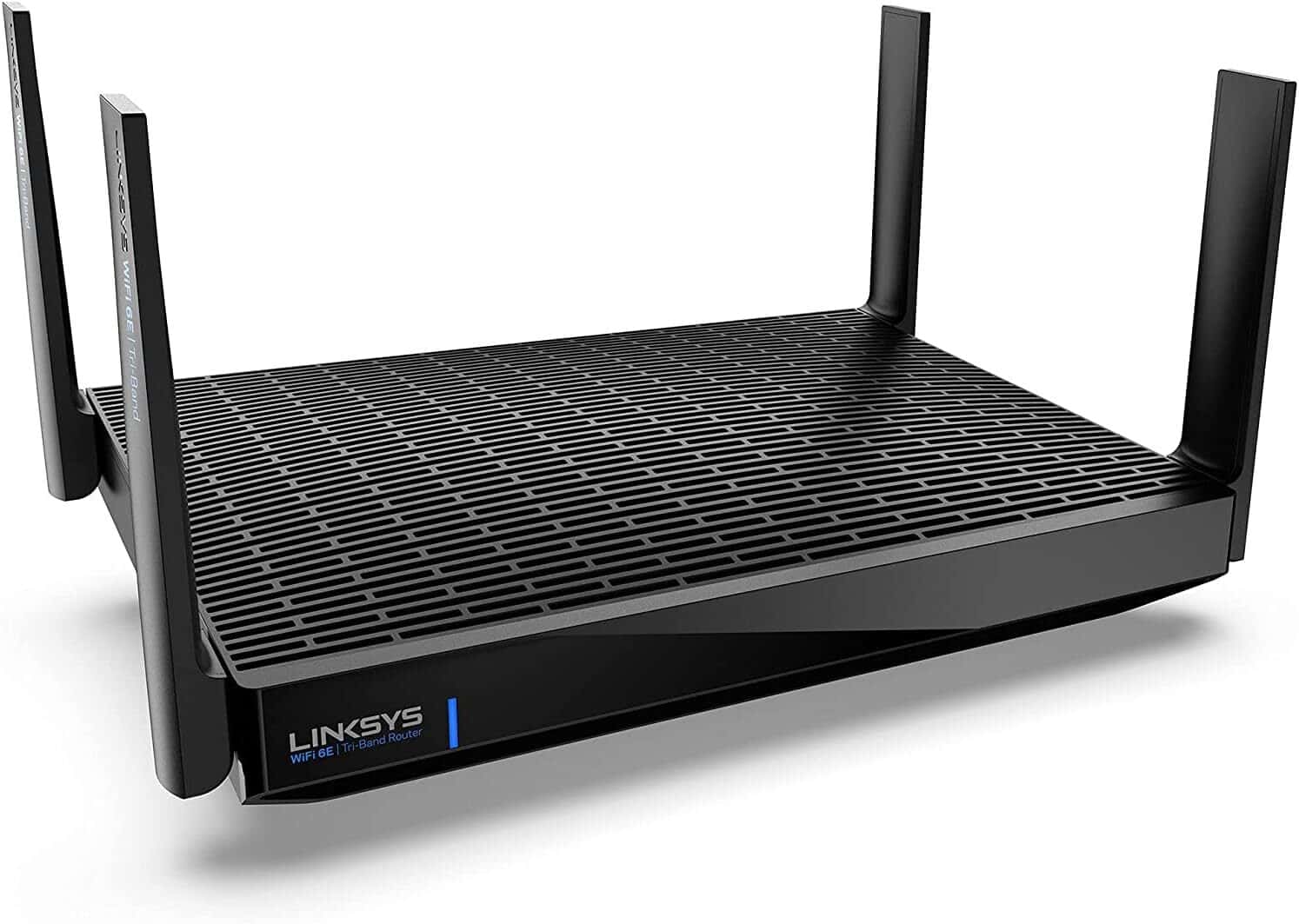
- WiFi Range: Up to 2,500 Sq Ft
- Suitable Internet Plan: 2 Gbps
- Number of Devices Supported: 55+
- Frequency Bands: Tri-band
- Ports: 1 x 5G WAN + 4 x Gig LAN + 1 x USB 3.0
If you’re interested in Linksys, then its WiFi 6E offering, MR7500, is probably one of the best. With top-notch features like a 5 Gbps WAN port, 6600 Mbps maximum speed capacity, excellent processor, and decent RAM, keep it ahead of most WiFi 6E-compliant routers in the same range.
Besides, if you compare it with Linksys MR7350, you’ll find the company has taken a leap forward in almost every aspect, be it speed, coverage, or overall performance.
Why is it a suitable choice?
MR7500, despite not being the latest offering by Linksys, still stays ahead of the most, be it in terms of speed and coverage; you can also trust it to deliver better stability and consistency. Another aspect that makes it stand out amongst its siblings is the presence of a multi-gig ethernet port that supports speeds up to 5 Gbps, the highest of the lot.
Speeds and WiFi Coverage
Linksys MR7500 boasts an excellent throughput of 6600 Mbps, and band-wise distribution is as follows:
| 6 GHz: 4800 Mbps | 5 GHz: 1200 Mbps | 2.4 GHz: 600 Mbps |
I paired a 2 Gbps Xfinity plan to test download and upload speeds over three bands, and the results were pretty impressive.
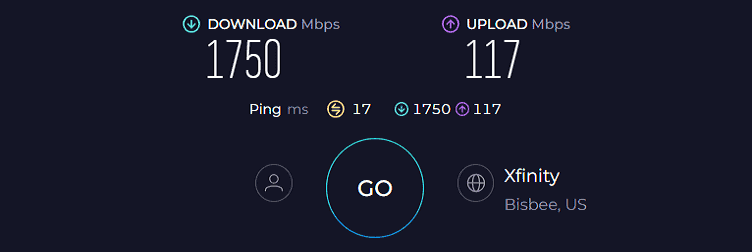
Over the 6 GHz band, respective values were recorded at 1.75 Gbps and 117 Mbps, while they were around 1.1 Gbps and 92 Mbps for the 5 GHz band.
The speeds over the 5 GHz band were although above a Gigabit, considerably weaker than my previous recommendations. At the same time, the 2.4 GHz band recorded respective speeds of 525 Mbps and 56 Mbps.
Despite inferior results, you can trust its reliability and consistency with closed eyes. I played games like Destiny 2, Valorant, and Fortnite, with minimal lags and latencies.
The routing device, although it had a decent performance in terms of coverage, as its four-antenna setup could transmit signals to up to 2,400 Sq Ft. And, courtesy of OFDMA and MU-MIMO, signals could easily breeze over to 45 devices simultaneously.
Security Features
I was a bit disappointed with the lack of any advanced features with this routing device, free or paid. It has only a few basic tools like WPA3, DDoS protection, VPN, guest access, and auto-firmware update. Nevertheless, such features should serve as a primary shield against unwanted agents.
And if you need much more powerful features, subscribe to any third-party antivirus powered by Tenda Micro or Bitdefender.
Conclusion
To summarize, Linksys MR7500 is a good mid-range 6E option with decent features to get the most out of your internet. It passed most of my tests, especially speeds with great scores, except security, which is why it’s ranked lower in the list.
But it should be a valuable device for anyone residing in a decent-sized space with multiple devices.
Pros
- Multi-gig WAN port
- Solid 6 GHz throughput
- Mesh capable
- Decent coverage
Cons
- Middling 5 GHz speeds
- Lacks advanced security tools and parental controls
6. Best WiFi 6E Mesh System: TP-Link Deco XE75
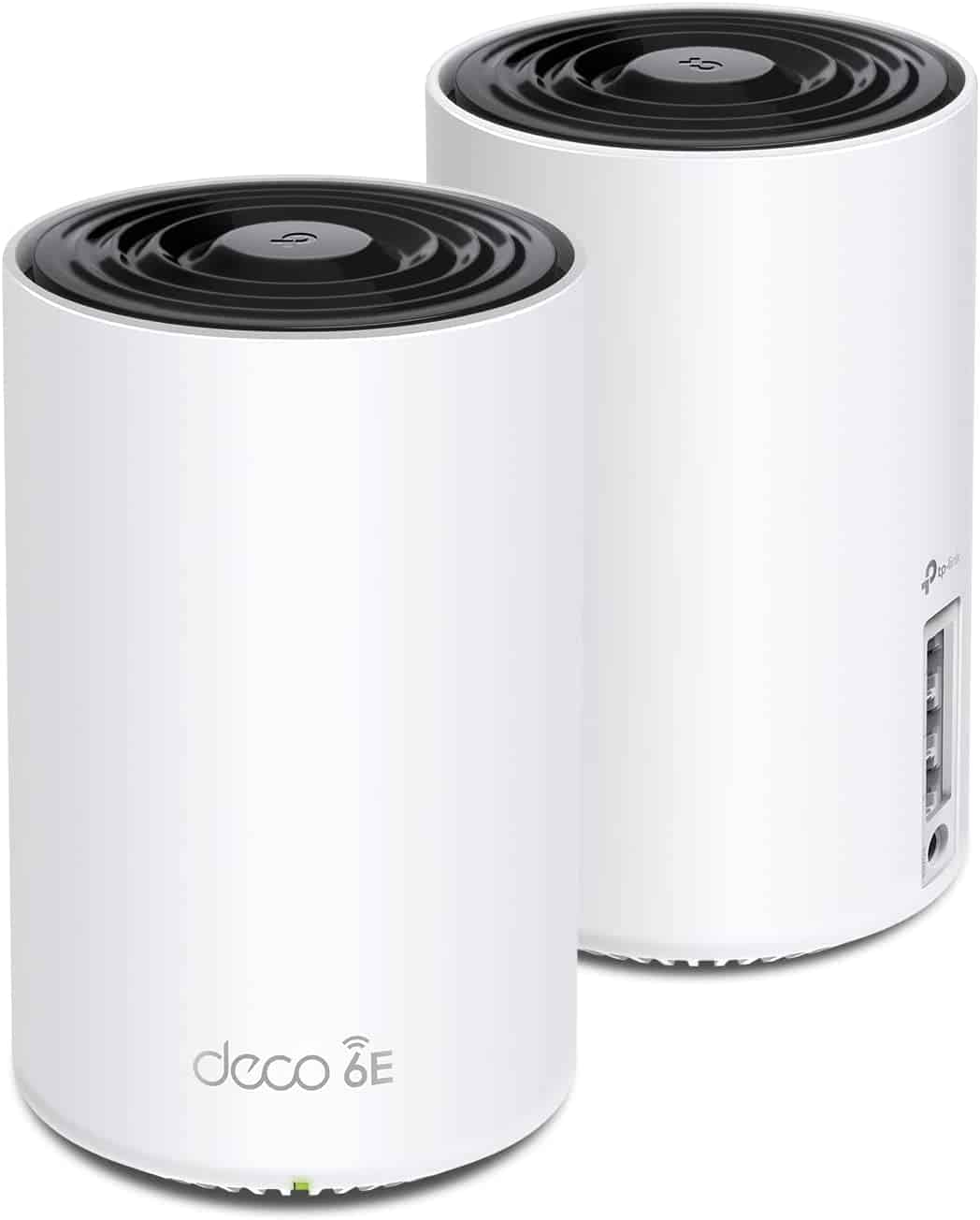
- WiFi Range: Up to 5,500 Sq Ft
- Suitable Internet Plan: 1 Gbps
- Number of Devices Supported: 200+
- Frequency Bands: Tri-Band
- Ports: 3 x Gig LAN (on each unit)
If you reside in a large two-story house and are agitated by weak or dead network spots, TP-Link Deco AXE5400 is one of the best WiFi 6E mesh WiFi systems. Its antennas can cover large homes, and its cutting-edge processor ensures you don’t run out of network anytime.
These features, especially the chip, make it a considerable upgrade over its preceding model, the TP-Link Deco X60.
Why is it a suitable choice?
Mesh systems, although known for their extensive coverage ability, and what’s better than a WiFi 6E WiFi system with a max 5,500 Sq Ft converge? It means you have congestion-free and stable signals throughout your large space. And the devices in your space should never run out of strong signals.
Speeds and WiFi Coverage
Deco boasts an aggregated speed of 5400 Mbps, distributed over three bands:
| 6 GHz: 2402 Mbps | 5 GHz: 2402 Mbps | 2.4 GHz: 574 Mbps |
I paired the Xfinity 1 Gbps plan with three bands and measured download and upload speeds.
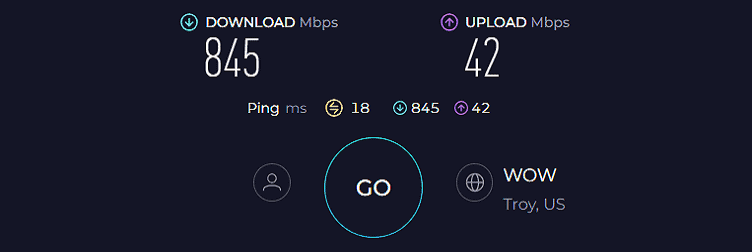
Its 6 GHz band, with more available channels, had the fastest speeds, clocking around 954 Mbps and 38 Mbps, while values for 5 GHz remained at 796 Mbps and 31 Mbps, respectively. Similarly, the 2.4 GHz clocked speeds at 503 Mbps and 22 Mbps.
And courtesy of highly-amplified antennas and a two-node setup, these speeds were spread up to 4,200 Sq Ft. With near-gig speeds spread over your large workspace, trust me on this, you will never receive complaints about a bad network or weak signals from your employees.
Courtesy of MU-MIMO and OFDMA signals on up to 83 devices stayed consistent and stable. I think it can further handle 20-25 devices, provided you have that many at your disposal.
Security Features
As with most TP-Link devices, features like access control, guest access, VPN, WPA3, and auto-security updates are available right away with TP-Link HomeShield basic.
Besides, there’s an option to pay a certain amount to get access to its advanced security features like anti-malware, intrusion blocking, and others.
Regarding parental controls, you can check how many hours your kids are online and pause the internet if they spend too much time. Also, it allows you to block certain websites that you consider inappropriate for your kids.
Conclusion
TP-Link Deco AXE5400 is an excellent WiFi 6E mesh router with standard features for your daily internet needs without costing much. Its coverage and device-holding ability are its standout features. But its security features and port setup could have improved, which is why it’s ranked in the penultimate position.
Pros
- Value-based mesh WiFi
- Faster and consistent speeds
- Exceptional coverage
- Simple setup & management
- Good security features
Cons
- Lesser ports
7. Cheapest Option: Tenda RX27 Pro
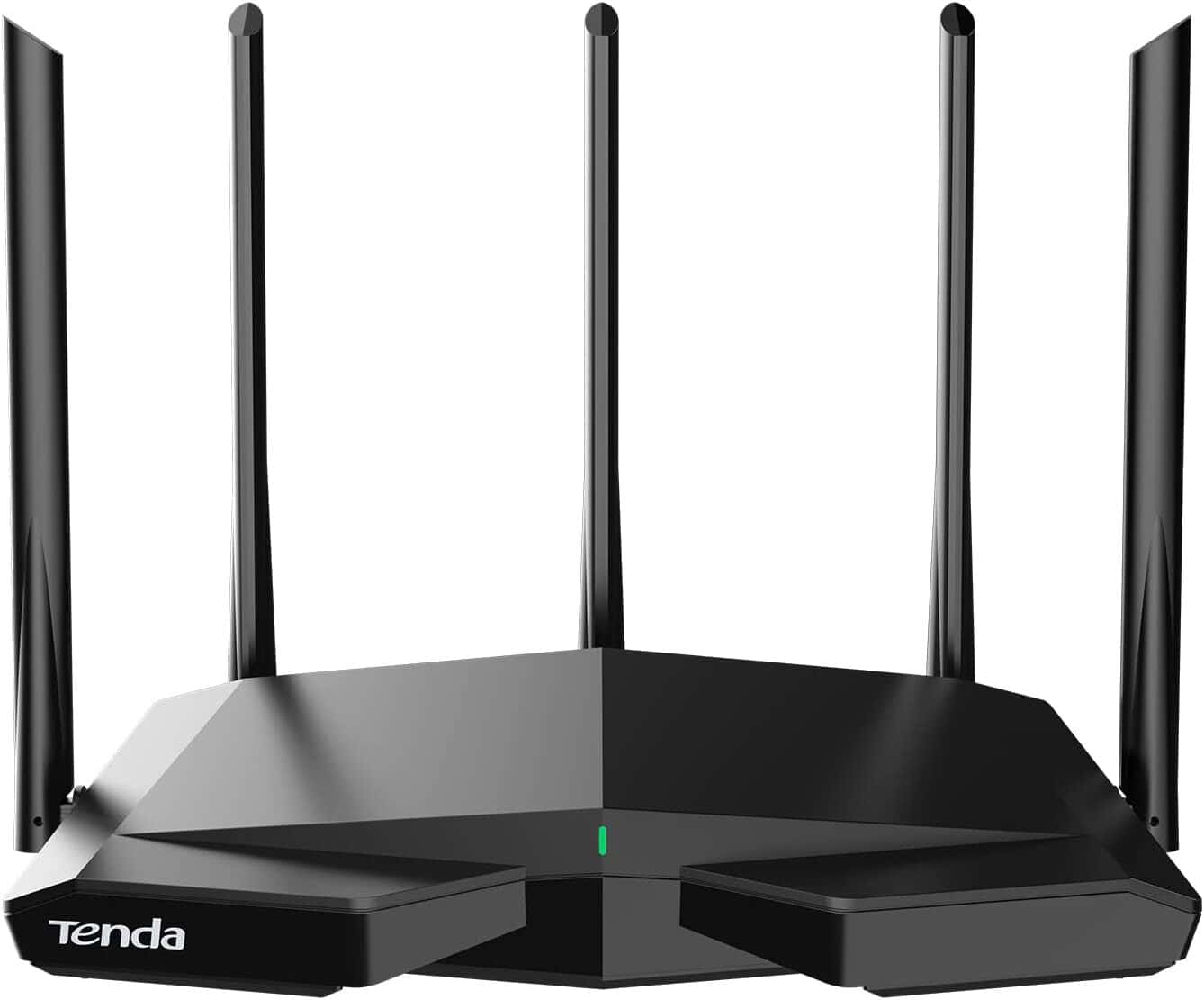
- WiFi Range: Up to 2,500 Sq Ft
- Suitable Internet Plan: 500 Mbps
- Number of Devices Supported: 50+
- Frequency Bands: Tri-Band
- Ports: 1 x Gig WAN + 3 x Gig LAN
Last but not least is the budget 6E router, Tenda AXE5700, which doesn’t compromise much despite its price. It replaces Tenda’s flagship Wi-Fi 6 inbuilt Tenda TX9 router by bringing in multiple upgrades in terms of speeds, coverage, processing ability, and ports which further translates to a much-improved performance.
Why is it a suitable choice?
With advanced features in terms of processing abilities, speeds, and coverage, these routing devices get very expensive. But at around $160, it’s sure to get you exceptional performance and handle most heavy tasks, making it the cheapest option available.
Speeds and WiFi Coverage
An aggregated speed of 5400 Mbps of Tenda AXE5700 is distributed amongst three bands as follows:
| 6 GHz: 2402 Mbps | 5 GHz: 2402 Mbps | 2.4 GHz: 574 Mbps |
To test its performance, I used my Dell laptop equipped with WiFi 6E circuitry, and its download speeds of 489 Mbps on the 6 GHz band with the Cox 500 Mbps plan was impressive. The upload speeds over the same band turned out at 19 Mbps.
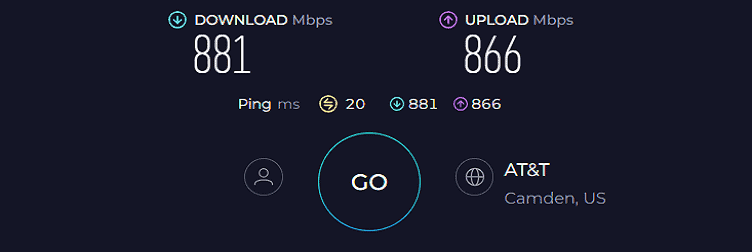
Its 5 GHz band, a victim of congestion and traffic, recorded speeds at 422 Mbps and 16 Mbps. The recorded speeds are more than many products in a similar price range. Its best part is its 2.4 GHz speeds, valued at 347 Mbps and 12 Mbps.
Tenda AXE5400’s performance was also decent in the 30-foot test, where speeds only dropped by 40%, but signals were stable, courtesy of MU-MIMO and OFDMA.
Its five-antenna setup could cover an area of up to 2,000 Sq Ft, on par with many products higher on this list. Besides, I could connect up to 42 devices (including laptops, mobile devices, gaming consoles, and smart TVs). That’s a great performance for such a budget offering.
Security Features
Security features like guest network access, automatic firmware updates, WPA3 security protocol, standard-based WiFi security, and VPN support are included with the AXE5400. These features aid in protecting your home network and devices from external threats and ensuring the secure data transfer of information.
Conclusion
Tenda AXE5400 is an entry-level WiFi 6E router with some above-average features to satiate some network-hungry devices in your space. It entails technologies like OFDMA and MU-MIMO to make sure stability in signals is maintained despite connecting multiple devices at once.
However, many features like coverage and security features could have seen some improvement and thereby ranked last.
Pros
- Great speeds
- Decent coverage
- MU-MIMO and OFDMA
- Easy to install
Cons
- Security is pretty basic
Why Get a WiFi 6E Router?
- A new 6 GHz band comes with seven additional 160 MHz, while WiFi 6 operates over the same congested network. As a result, routers with 6E saw a six times increase in speed over its predecessor.
- WiFi 6E minimizes the time required to pass data from a router to the client devices or vice versa. This, in turn, reduces the lag time for applications like gaming and video conferencing.
- Intel confirms that 6E is more efficient and reliable thanks to the 6 GHz band.
- The latest standard made advancements concerning the antennas it supports, which further enhances speeds and allows multiple users to share the bandwidth simultaneously.
Frequently Asked Questions
As of now, Wi-Fi 6 should work for most people. Otherwise, these standards are backward compatible, meaning a Wi-Fi 6 router is compatible with Wi-Fi 5, Wi-Fi 4, and others. So, if you are considering investing in a new device with no budget restrictions, a Wi-Fi 6E should keep you future-proof.
There are multiple advantages of 6E to Wi-Fi 6, courtesy of an additional 6 GHz band and numerous channels for faster data transfer. Aside from that, it enhances a router's signal transmission ability, helps minimize latency, and improves reliability. So, in short, Wi-Fi 6E is better than Wi-Fi 6.
Yes, there are. Here it goes:
– Wi-Fi 6E routing devices are generally more expensive
– As of now, only a few devices support Wi-Fi 6E
– You would need a Gigabit-class connection to utilize the standard fully
– The 6 GHz band has a shorter range compared to the 5 GHz and 2.4 GHz bands
The higher the frequency, the lesser distance it can travel, and its penetration ability will be less. In my testing, the signals couldn’t be extended farther than 50 feet with other networking devices and walls.
Verdict
The 6 GHz routers are the newest addition to the market, but increasing popularity amongst users has propelled manufacturers to launch new products. This has made users research more, especially because they lack an understanding of how it works.
I hope my detailed review-based guide has given you an idea about these routing units and helped you choose. If you're still confused, here’s a curated list of the best options in all categories:
- If you don’t want to compromise less than great and aren’t restricted on budget, the TP-Link Archer AXE300 is the best you can get.
- For people who don’t want to spend much yet are keen on a functional device, go for TP-Link Archer AXE75.
- Lastly, if you want the cheaper 6E router, opt for Tenda AXE5700. It has some handy features like a Quad-Core processor, ample RAM, and throughput capacity.
With that comes the end of my top picks. Aside from these, you can get an option that suits your needs but ensure you don’t end up with an inferior device.


